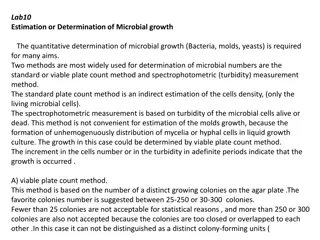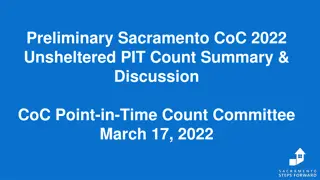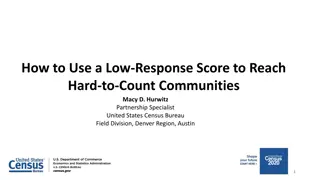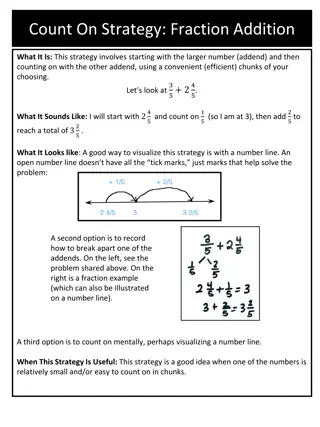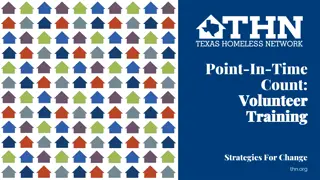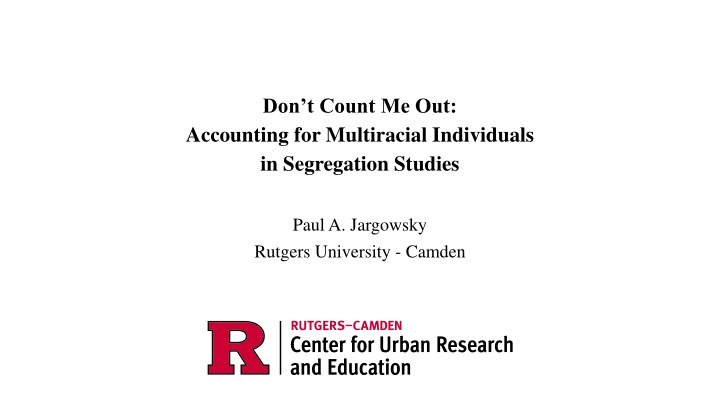
Accounting for Multiracial Individuals in Segregation Studies: A Detailed Analysis
Explore the dynamics of multiracial identities in segregation studies, examining the impact of changes in Census racial classifications from the 1990s to present times. Delve into the complexities, growth trends, and misconceptions surrounding the multiracial population in the US, shedding light on the nuances of identity categorization.
Download Presentation

Please find below an Image/Link to download the presentation.
The content on the website is provided AS IS for your information and personal use only. It may not be sold, licensed, or shared on other websites without obtaining consent from the author. If you encounter any issues during the download, it is possible that the publisher has removed the file from their server.
You are allowed to download the files provided on this website for personal or commercial use, subject to the condition that they are used lawfully. All files are the property of their respective owners.
The content on the website is provided AS IS for your information and personal use only. It may not be sold, licensed, or shared on other websites without obtaining consent from the author.
E N D
Presentation Transcript
Dont Count Me Out: Accounting for Multiracial Individuals in Segregation Studies Paul A. Jargowsky Rutgers University - Camden
Changes in Census Racial Classifications 1990s social movement to recognize multiracial people Reclassify All Children Equally (RACE) Association of Multiethnic Individuals Wanted a separate multiracial category But that category combines many dissimilar types. Instead, in 2000, instructions changed to mark one or more boxes. However, the Hispanic ethnicity question was not changed.
Since each combination can be Hispanic or non-Hispanic, there are 63 x 2 = 126 possibilities!
The Growing Multiracial Population The population of these individuals grew 32 percent from 6.8 million in 2000, when the Census Bureau first allowed respondents to identify as multiracial, to 9.0 million in 2010.
A Multiracial Boom? An astounding 276 percent increase between 2010 and 2020, dubbed a multiracial boom in the media. Rises from 2.9 to 10 percent of US population! However, it turns out to be an illusion based on changes in the Census Bureau coding algorithms (Starr and Pao 2024).
Black: Metros with Highest Percent Multiracial 2000 2010 Black Alone or in Combination Black Alone or in Combination % Multi- racial % Multi- racial Highest Black % Multiracial (100,000 minimum) Seattle-Bellevue-Everett, WA Sacramento--Arden-Arcade--Roseville, CA San Diego-Carlsbad-San Marcos, CA Phoenix-Mesa-Glendale, AZ Minneapolis-St. Paul-Bloomington, MN-WI Denver-Aurora-Broomfield, CO Oklahoma City, OK Las Vegas-Paradise, NV Riverside-San Bernardino-Ontario, CA Pittsburgh, PA 122,372 140,110 174,418 127,227 180,006 124,682 121,620 131,766 263,591 200,943 17.00 11.60 11.40 11.00 13.70 9.70 6.80 7.90 8.00 5.50 164,886 178,639 173,327 225,946 276,987 156,360 145,758 218,545 336,944 216,539 19.00 15.80 15.40 14.40 13.80 13.40 12.10 10.90 10.50 10.20
Prior Methods A common approach is to ignore multiracial persons, contrast non-Hispanic single-race whites with non-Hispanic single-race blacks. The Logan Rule: Our approach for handling multiple race responses is to treat a person as black if they described themselves as black plus any other race; as Asian if they listed Asian plus any other race except black; and as Native American/other race for any other combination (Logan and Stults 2011: 24). Glaeser and Vigdor (2012) follow the exact opposite approach. They identify blacks as those who are indicate black as their only race. They then compute segregation indices of blacks, so defined, from non-blacks including all whites, Hispanics, and multiracial persons, some of whom are partly black. None of these methods reflects the reality of people who span 2 or more races.
How to calculate White/Black segregation? Black Other Races (Single Race) 4 White (Single Race) 1 (Single Race) 1 White + Other (2 Races) 4 Black + Other (2 Races) 4 Other + Other (2 Races) 6 White + Black (2 Races) 1 White + Others (3+ Races) 11 White + Black + Others (3+ Races) 15 Black + Others (3+ Races) 11 Other Races in Combination (3+ Races) 5
Approach 1: Ignore multiracial persons Black Other Races (Single Race) White (Single Race) (Single Race) White + Other (2 Races) Black + Other (2 Races) Other + Other (2 Races) White + Black (2 Races) White + Black + Others (3+ Races) Other Races in Combination (3+ Races) White + Others (3+ Races) Black + Others (3+ Races)
Approach 1a: treat multiracial as a category Black Other Races (Single Race) White (Single Race) (Single Race) White + Other (2 Races) Black + Other (2 Races) Other + Other (2 Races) White + Black (2 Races) White + Black + Others (3+ Races) Other Races in Combination (3+ Races) White + Others (3+ Races) Black + Others (3+ Races)
Approach 2: Logan and Stults (2011) Black Other Races (Single Race) White (Single Race) (Single Race) White + Other (2 Races) Black + Other (2 Races) Other + Other (2 Races) White + Black (2 Races) White + Black + Others (3+ Races) Other Races in Combination (3+ Races) White + Others (3+ Races) Black + Others (3+ Races)
Approach 3: Glaeser and Vigdor (2012): The End of Segregated Century Black Other Races (Single Race) White (Single Race) (Single Race) White + Other (2 Races) Black + Other (2 Races) Other + Other (2 Races) White + Black (2 Races) White + Black + Others (3+ Races) Other Races in Combination (3+ Races) White + Others (3+ Races) Black + Others (3+ Races)
What we need, but how to do it? Black Other Races (Single Race) White (Single Race) (Single Race) White + Other (2 Races) Black + Other (2 Races) Other + Other (2 Races) White + Black (2 Races) White + Black + Others (3+ Races) Other Races in Combination (3+ Races) White + Others (3+ Races) Black + Others (3+ Races)
Taking account of multiple races Black White = Weight 1 (Single Race) (Single Race) 1 2 White + Other (2 Races) Black + Other (2 Races) White + Black (2 Races) = Weight White + Black + Others (3+ Races) 1 1 1 1 , , , 3 4 5 6 White + Others (3+ Races) Black + Others (3+ Races) = Weight
Index of Dissimilarity ( ( ) = = = b B w W M % black in neighborhood 1 p j b p n w p n 1 2 j j j j j j j j j = D ) = = = % black in metro area 1 P B PN W P N = 1 j ( ) ) 1 p n p n PN M M 1 2 1 1 j j j j = = D n p P ( ( ) j j 1 P N 2 NP P = = 1 j 1 j = integration D = 0 If complete , p for all tracts, then . P j j= segregation D = 1 If complete , p 0 or 1 for all tracts, then .
Maximum Segregation with Multiracial People Segregation is the separation of groups over neighborhoods. In this scenario, segregation is maximized, but D = 0.667 Nobody can be moved to increase D. We need to normalize by the segregation of individuals. When everybody is in just one group, individual segregation is 1. But with multiracial persons, whiteness and blackness is mixed within multiracial persons.
Normalizing by segregation across individuals D D Segregation over Neighborhoods Segregation over Individuals j = = Multiracial D i M 1 1 Neighborhoods: M = D n p P ( ) j j j n p P 2 NP P j j = 1 j D D = 1 N j j = = MRD N 1 1 i = p P D p P Individuals: ( ) i i i 2 NP P = 1 = i 1 i Based on ideas from Information Theory (Shannon 1948). Jargowsky, Paul A., and Jeongdai Kim. 2009. The Information Theory of Segregation: Uniting Segregation and Inequality in a Common Framework. Research on Economic Inequality 17 (October):3 31.
MRD ranges from 0 to 1 Neigborhood 1 Neighborhood 2 Neighborhood 3 D D 0.667 0.667 j 99 White and Black = = = 1 MRD 99 White 99 Black i Neigborhood 1 33 White, 33 Black, 33 White/Black Neighborhood 2 33 White, 33 Black, 33 White/Black Neighborhood 3 33 White, 33 Black, 33 White/Black D D 0 j = = = 0 MRD 0.667 i The segregation of neighborhoods can never be greater than the segregation of individuals. Thus, the normalization ensures that MRD ranges from 0 (perfect integration) to 1 (maximum segregation).
Change between 2000 and 2010 .6 .4 Logan Rule MRD Single Race .2 0 2000 2010
Conclusion The Index of Dissimilarity can be applied in a theoretically justified manner to populations containing mixed-race individuals. There are multiracial versions of other segregation measures, for example, Entropy and Gini, based on the same ideas (Jargowsky and Kim 2009). As the multiracial population grows, this may become increasingly relevant. Possible applications in other areas.




